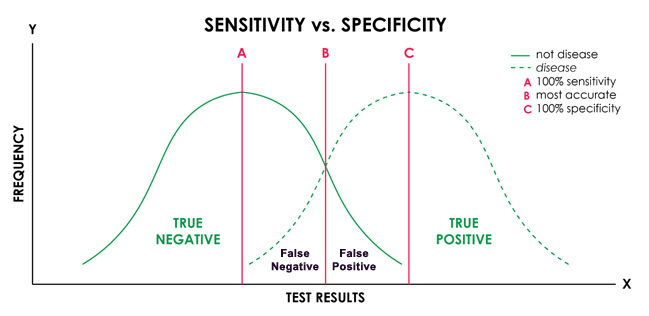What are Sensitivity & Specificity?
Sensitivity and Specificity describe the accuracy of a test which reports the presence or absence of a condition. Persons for which the condition is satisfied are considered “positive.” Persons for which the condition is not satisfied are considered “negative.”
Test sensitivity is the ability of a test to correctly identify those with the disease (true positive rate). Test specificity is the ability of the test to correctly identify those without the disease (true negative rate).
Sensitivity & Specificity Definition
| Sensitivity (SN) | Specificity (SP) |
|---|---|
| – probability of a Positive Test among patients with disease | – probability of a Negative Test among patients without disease |
| – help to identify patients WITH disease (True Positives) | – help to identify patients WITHOUT disease (True Negatives) |
| – highly Sensitive Tests are best used to Rule Out disease | – highly Specific Tests are best used to Rule In disease |
Sensitivity vs Specificity Graph

True Positive (TP), False Positive (FP) , False Negative (FN), True Negative (TN)
| Patients WITH Condition | Patients WITHOUT Condition | |
|---|---|---|
| Patients who test POSITIVE (Positive Predictive Value) | True Positive (TP) | False Positive (FP) |
| Patients who test POSITIVE (Positive Predictive Value) | False Negative (FN) | True Negative (TN) |
| Negative Predictive Value (NPV) | Positive Predictive Value (PPV) |
|---|---|
| Percentage of patients who both test negative and do not have disease (true negatives) | Percentage of patients who both test positive and have the disease (true positive) |
Sensitivity Specificity Formula
| Sensitivity Specificity Formula | DEFINTION |
|---|---|
| SENSITIVITY FORMULA:
Sensitivity (Sen) = TP/ (TP + FN) |
– percentage of patients with the disease that receive a positive result – percentage chance that the test will correctly identify a person who actually has the disease |
| SPECIFICITY FORMULA:
Specificity (Spec) = TN / (TN + FP) |
– percentage of patients without the disease that receive a negative result – percentage chance that the test will correctly identify a person who is disease-free |
| Negative Predictive Value (NPV) | Positive Predictive Value (PPV) |
|---|---|
| Percentage of patients who both test negative and do not have disease (true negatives) | Percentage of patients who both test positive and have the disease (true positive) |
Sensitivity Specificity Example
- If 100 patients known to have a disease were tested, and 48 test positive, then the test has 48% sensitivity.
- If 100 with no disease are tested and 94 return a completely negative result, then the test has 94% specificity.
Notes:
- Sensitivity and specificity are prevalence-independent test characteristics, as their values are intrinsic to the test and do not depend on the disease prevalence in the population of interest.
- Sensitivity & specificity by themselves are only useful when they are very high (-95% or higher).
- Predictive values help answer the question: “Given a positive or negative test result, what is the new probability of disease?”
- In medical diagnosis, test sensitivity is the ability of a test to correctly identify those with the disease (true positive rate)
- In medical diagnosis, test specificity is the ability of the test to correctly identify those without the disease (true negative rate).